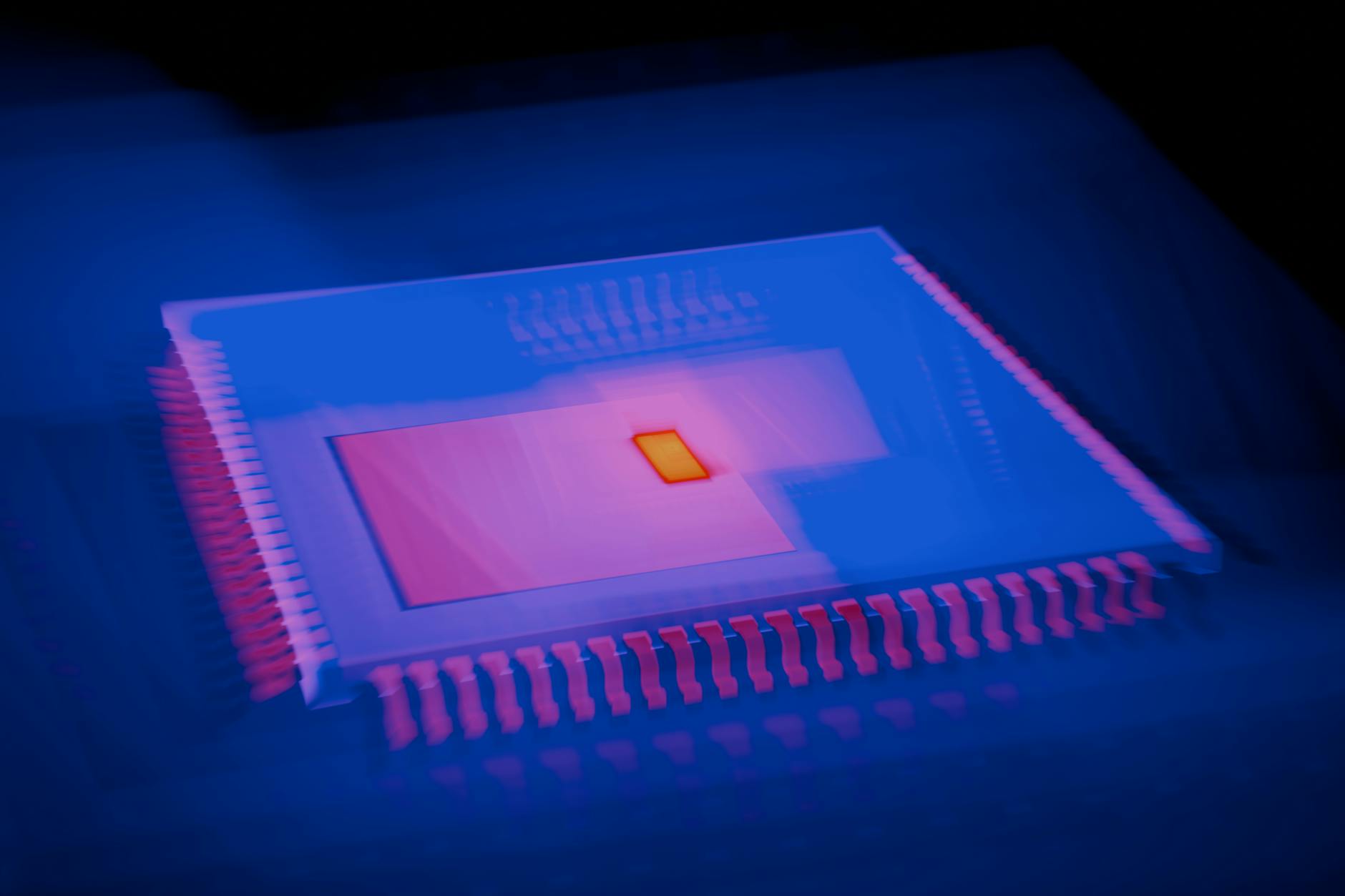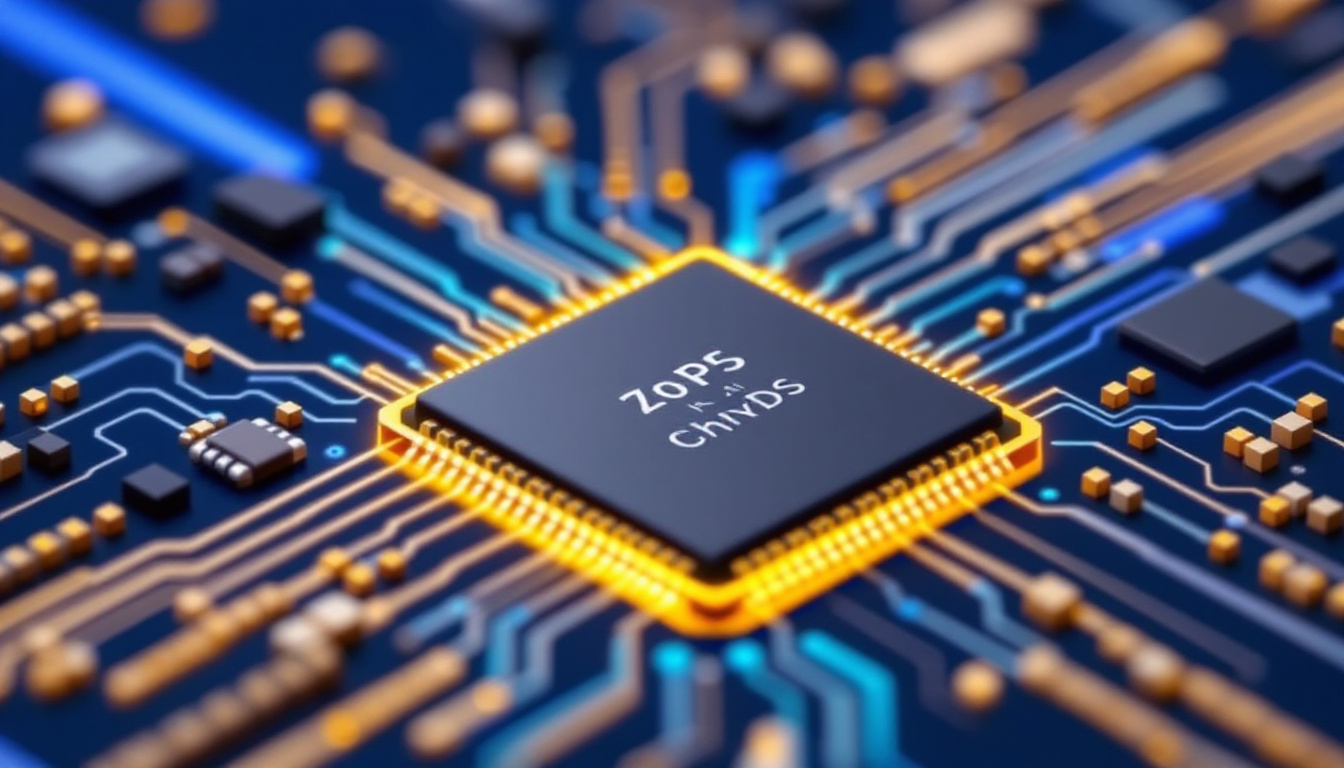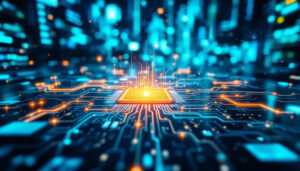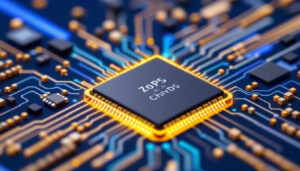Many laptops now include AI chips, reflecting a major shift in hardware design. These specialized components process tasks that go beyond basic computing. AI chips allow for faster data handling and smarter, real-time features. For IT professionals, developers, electronics enthusiasts, and businesses, this means laptops can support more advanced workloads at higher speeds.
With demand for intelligent automation and instant responses rising, these chips are shaping how people approach work and innovation. They bring improvements in efficiency, security, and user experience. For a closer look at how these advancements fit within the broader context of technology’s evolution, the history of the microchip provides useful background. This post will examine how AI chips transform laptops and what this means for today’s professionals. “Practical Benefits of AI Chips for Faster, Smarter Laptops in 2025”
What Are AI Chips and How Do They Differ from Traditional Processors?
Laptops today depend on more than just raw speed or battery life—they rely on specialized hardware to handle intelligent tasks efficiently. AI chips stand at the center of this shift. Unlike classic CPUs or GPUs, AI chips are purpose-built for processing artificial intelligence workloads, such as voice assistants, facial recognition, and predictive analytics. These emerging processors have unique architectures and capabilities that set them apart from traditional designs.
The Evolution of Laptop Hardware: Enter the AI Era
 Photo by Pixabay
Photo by Pixabay
The development of laptop hardware has followed a clear trajectory, moving from early microprocessors that managed single operations to today’s systems that support multitasking and high-speed connectivity. Moore’s Law historically predicted steady improvements in chip performance and density, but the pace of innovation accelerated with new demands from artificial intelligence.
AI chips emerged as computing needs shifted toward complex, real-time analysis and smarter applications. While CPUs remain essential for general-purpose processing, and GPUs provide parallel computing for graphics and some AI work, AI chips—often called NPUs or neural engines—deliver efficient machine learning on the device itself. This change reflects a broader transformation highlighted by the history of the microchip, which chronicles how specialized hardware has always responded to rising technological complexity.
In recent years, leading tech companies have incorporated AI chips directly into consumer and business laptops. For example, Apple’s M-series processors, Qualcomm’s Snapdragon X Elite, and Intel’s Core Ultra series include advanced AI hardware. These chips are not standalone replacements for CPUs, but tightly integrated components that offload resource-heavy cognitive workloads.
If you track trends in IT and development, the growing adoption of edge devices and local inference is a key theme. Dedicated AI chips now handle on-device analysis, removing the need for cloud round-trips and bringing instant responsiveness—a theme explored further in our analysis of digital product trends for IT pros in 2025.
Key Components and Functions of AI Chips in Laptops
AI chips feature unique architectural choices that set them apart from traditional chips. Central to their design are components like NPUs (Neural Processing Units), which are optimized for accelerating machine learning and deep learning operations.
Distinctive Characteristics of AI Chips:
- Neural Processing Units: Unlike standard CPUs, NPUs are designed to process large numbers of mathematical operations simultaneously. This enables efficient handling of AI workloads, such as natural language processing and image classification.
- On-Device Machine Learning: AI chips enable real-time inferencing. They process data locally instead of sending it out to the cloud, increasing security and reducing latency—essential for privacy-sensitive or time-critical applications.
- Energy Efficiency: These chips execute AI computations using less power than CPUs or GPUs would for similar tasks, which is especially important in portable devices like laptops.
- Parallel Processing: By handling multiple operations concurrently, AI chips improve performance in multitasking environments.
The functions of AI chips go well beyond simple calculations:
- Augmented Security: Enhanced biometric authentication uses AI processing to identify users more reliably.
- Improved Communication: Features like live translation, background noise cancellation, and smart voice input depend on local AI hardware.
- Image and Video Enhancement: Tasks like image upscaling, facial detection, and real-time background blurring are handled swiftly by these chips.
The differences between AI chips and traditional processors matter because they enable:
- Faster Response Times: Local processing eliminates most delays.
- Greater Privacy: Sensitive data is analyzed on the device, not sent to external servers.
- Support for New Applications: Laptops can now offer features that previously required external resources or high-powered desktops.
A detailed breakdown of how AI chips compare to CPUs and GPUs is available in resources such as A brief overview of AI chips vs traditional chips. For an in-depth comparison of chipset approaches across devices—including those used in mobile and desktop settings—see our iPhone 2025 vs Android flagship comparison.
AI chips mark a turning point in how laptops operate, providing the foundation for smarter, more responsive devices that meet the demands of today’s data-driven world.
Speed and Efficiency: How AI Chips Supercharge Laptop Performance
AI chips redefine what users expect from laptop performance. They move beyond traditional speed boosts, shifting the focus to efficiency, workload offloading, and optimized battery life. By running machine learning and automation tasks on-device, AI chips accelerate essential workflows. This capacity delivers better speed, smarter multitasking, and significant user experience improvements for professionals and business users.
AI-Accelerated Tasks: From Productivity to Creativity

Photo by Matheus Bertelli
AI chips add the ability to process demanding tasks directly on the laptop. This translates to real gains for both creative and professional activities. Examples of these AI-accelerated workflows include:
- Photo and Video Editing: AI chips enable real-time upscaling, background blur, noise reduction, and object recognition within editing apps. Editors experience smoother previews, faster rendering times, and instant effect application—even with high-resolution footage.
- Virtual Assistants: Tasks triggered by voice input, such as setting reminders or scheduling meetings, are executed more quickly with on-device inference. This preserves privacy while reducing response delays, especially for mobile professionals.
- Translation: Real-time translation is now possible even offline. Laptops with AI chips can instantly convert speech or text, helping global teams or traveling business users communicate without lag.
- Real-Time Analytics: For developers and IT professionals, AI accelerates anomaly detection, log parsing, and predictive analytics directly on the device. This reduces time-to-insight and supports better workflow decisions.
- Automation: Repetitive tasks—like document formatting, invoice scanning, or data sorting—are managed with higher accuracy by AI chips, reducing manual workload.
For software developers, local AI can assist with code autocomplete, error detection, or security scanning as they write, making daily development more efficient. Business users benefit from enhanced meeting transcription, smart note summarization, and advanced spreadsheet operations powered by AI. These new abilities are summarized on discussion threads such as AI PCs are better than normal PCs because they come with dedicated AI hardware, confirming real improvements in speed and task execution that users have observed.
By bringing advanced features into everyday workflows, AI chips allow laptops to efficiently handle multitasking and heavy workloads without slowdowns or heat build-up. This shift is particularly relevant for industries that depend on efficiency under tight deadlines.
Battery Life and Thermal Management Advantages
AI chips also transform how laptops use power and manage heat. Traditional power management relies on static rules—reducing CPU clock speed or dimming the display to save energy. AI chips, in contrast, use predictive algorithms and context-aware controls to optimize every watt consumed.
Key advantages of AI-based energy management include:
- Adaptive Power Usage: Laptops sense when workloads require high power and when they can shift to low-energy modes, making adjustments in real time. This keeps performance high during demanding tasks but conserves energy for lighter use.
- Smarter Cooling: AI can predict when thermal thresholds will be reached, activating fans or throttling performance strategically. This keeps devices cool without sudden changes in speed or unnecessary fan noise.
- Extended Battery Life: By offloading specific machine learning operations to NPUs, the CPU and GPU are freed up, reducing overall energy draw. Tests and early adopters report that laptops with AI hardware often achieve longer battery runtimes, especially during productivity tasks.
For business professionals working on the move, these improvements mean longer usable hours and fewer interruptions. Developers and IT users will notice laptops stay cooler and quieter, even during resource-heavy builds or analytics. Discussions such as AI-based processors and daily use battery life show that many users now achieve the coveted 10+ hour battery life mark thanks to AI chips optimizing power in real time.
Compared to older systems that used simple logic to manage power and heat, laptops equipped with dedicated AI hardware become both smarter and more efficient in their daily operations. These improvements not only enhance user comfort but also support sustainability by reducing energy waste.
Related topics on device performance, cooling, and battery optimization are further explored within our reviews of laptop performance and reliability and can help readers choose devices that best fit demanding professional environments.
Smarter Computing: Enhanced Features and User Capabilities
Laptops equipped with AI chips are changing how users manage privacy, security, and daily interaction. With rapid processing on device, key features once reserved for enterprise systems are now standard in consumer and business laptops. Security becomes adaptive, interfaces become smarter, and user experiences grow more inclusive.
Security and Privacy Powered by AI

Photo by Pixabay
AI chips have redefined how laptops approach security and privacy. On-device AI manages sensitive tasks such as biometric authentication, instant encryption, and monitoring for threats—functions that were once slow or required cloud access.
Key security enhancements now available:
- Biometric Authentication: AI chips process facial and fingerprint data locally for login and access control. This reduces data exposure since biometric information stays on the device.
- Real-Time Threat Detection: AI models watch for unusual behavior or malware attempts and respond immediately, reducing risk before a threat can spread.
- Encryption: Sensitive files and conversations are protected with fast, AI-driven encryption algorithms that adapt to usage and risk level.
This shift toward local processing mirrors advances in security features in next-generation consumer electronics. The combination of hardware and AI means that security is not only faster but also more consistent, as seen in recent coverage on AI agents for biometric authentication and new strategies for preventing credential theft.
The presence of integrated AI in consumer devices leads to proactive protection, aligning security responsibilities with the device instead of distant servers. This is especially important for businesses and IT professionals who need to guarantee safety while complying with evolving privacy frameworks.
Intelligent User Experiences and Accessibility
AI chips also support user experience innovations that help a wider range of users. These improvements create more intuitive, responsive, and accessible computing.
Some standout capabilities include:
- Adaptive User Interfaces (AUI): Interfaces adjust visual layout, font size, and input methods based on user behavior and context, resulting in customized interactions every time. For an overview of how these interfaces function, reference the details on an Adaptive User Interface.
- Context-Aware Suggestions: Devices recognize user activities—such as meetings or presentations—and optimize notifications and controls to prevent interruptions and improve focus.
- Accessibility Features: AI makes speech-to-text, magnification, screen reading, and gesture navigation more reliable. It tailors these features in real time, helping users with various needs. Microsoft offers a summary of these functions in their guide to Windows accessibility features.
These AI-powered advances in accessibility mean laptops now address the needs of users with vision, hearing, mobility, or cognitive differences more effectively. The devices proactively refine their responses based on context and individual preference, making technology more inclusive and efficient.
Modern laptops are no longer just productive—they actively enable a safer, more accessible environment that works for everyone. For IT professionals seeking to deliver better outcomes for their teams, or businesses looking to improve workplace accessibility and security, these AI-driven advances signal stronger value and broader reach. For more on broader device technology strategies, our article on digital product trends for IT professionals and developers in 2025 provides a useful overview.
AI Chips and the Future of Laptop Innovation
AI chips stand at the forefront of changing how laptops function. Their influence extends beyond current performance enhancements, shaping trends for IT, development, and business. The next generation of laptops will reflect new standards for processing, security, and adaptability. As businesses plan, understanding these hardware changes is essential for long-term competitiveness.
Upcoming Advances in AI Hardware and Laptops
 Photo by Steve Johnson
Photo by Steve Johnson
AI chips will play a defining role in the expected evolution of laptops. Upcoming chipsets from leading manufacturers focus on tighter AI integration, improved energy efficiency, and real-time data analysis. The shift is not only about faster processing speeds, but also about supporting complex workloads including privacy-focused operations and federated learning.
The 2025 release cycle will highlight advances such as:
- Dedicated on-device AI engines that reduce the need for cloud computing, enhancing performance and privacy.
- Adaptive performance management for improved thermal control and battery life.
- Real-time translation, transcription, and image processing that will become standard even in midrange models.
These enhancements respond directly to new workloads faced by professionals and developers. For instance, AI-powered automation, local analytics, and multimedia handling increasingly require more specialized hardware. Disruption is also anticipated as hardware standards shift, such as increased adoption of Wi-Fi 7 and advanced memory architectures. These shifts are profiled in coverage around anticipated hardware launches for 2025 and guides like what’s new when shopping for a laptop in 2025.
The most forward-looking products, highlighted in summaries of the most anticipated electronic gadgets of 2025, will couple AI chips with features such as advanced biometric sensors and adaptive displays. This integration aligns with the trend toward local AI, which is set to transform how enterprise and individual users rely on their laptops (The Future of Local AI: Trends and Innovations). For organizations, early adoption of such capabilities can reduce operational delays, improve security posture, and empower staff to work smarter, not just faster.
AI Integration and Future-Proofing Strategies for IT Professionals and Businesses
As AI chips become standard, IT teams and procurement professionals face pressure to select laptops ready for rapid change. The following recommendations address both device selection and broader planning:
- Choose laptops with upgradable AI subsystems when possible. This can include modular AI accelerators or systems designed for firmware updates.
- Evaluate compatibility with emerging connectivity and hardware standards such as Wi-Fi 7 and fast solid-state storage for seamless integration with existing infrastructure.
- Place security and device management as top priorities—selecting devices with strong on-device encryption, AI-powered threat detection, and remote management capabilities.
- Plan for staff training and workflow updates as AI features become more deeply embedded in daily use.
Short- and long-term business strategy should also account for persistent changes in hardware cycles. Options such as staged rollouts—updating equipment for high-intensity users first—or leveraging cloud-managed device profiles, can help manage risk and cost. Forward-looking teams should reference home electronics future-proofing strategies to ensure device purchase decisions keep pace with standards changes and the needs of remote work.
Investing in laptops that are equipped for next-generation AI tasks, rather than just current requirements, supports agility and business continuity. As outlined in AI in Your Pocket: How Soon Will AI Hardware Be Everywhere?, the move from cloud-driven to on-device AI reduces latency and privacy concerns—a key driver for many business and IT leaders making procurement decisions today.
Planning with these considerations in mind positions organizations and individual professionals to adapt quickly. Laptops are not just tools for running applications, but platforms for secure, efficient, and intelligent work in a changing hardware environment. For a practical overview of how these trends align with current and future needs, IT leaders can benefit from resources on integrating smart home devices and enterprise technology.
Conclusion
AI chips have changed what laptops can do. They deliver faster processing, improved security, and smarter features directly to users. These benefits support better workflows and create new opportunities for IT professionals, developers, electronics experts, and businesses alike.
Staying updated with these advances is important for those guiding technology strategy. Hardware improvements, from AI chip integration to the adoption of new connectivity standards, will shape the business and technical environment in the years ahead. For those interested in how broader trends such as wireless innovation influence device performance, the review of emerging wireless standards in 2025 provides insight.
As laptops become smarter and better equipped for complex tasks, now is the time to review existing technology plans and prepare for future updates. Consider how AI-driven hardware can support your next project or improve your organization’s resilience. Thank you for reading—your feedback and experience with AI hardware are welcome as this shift continues.







